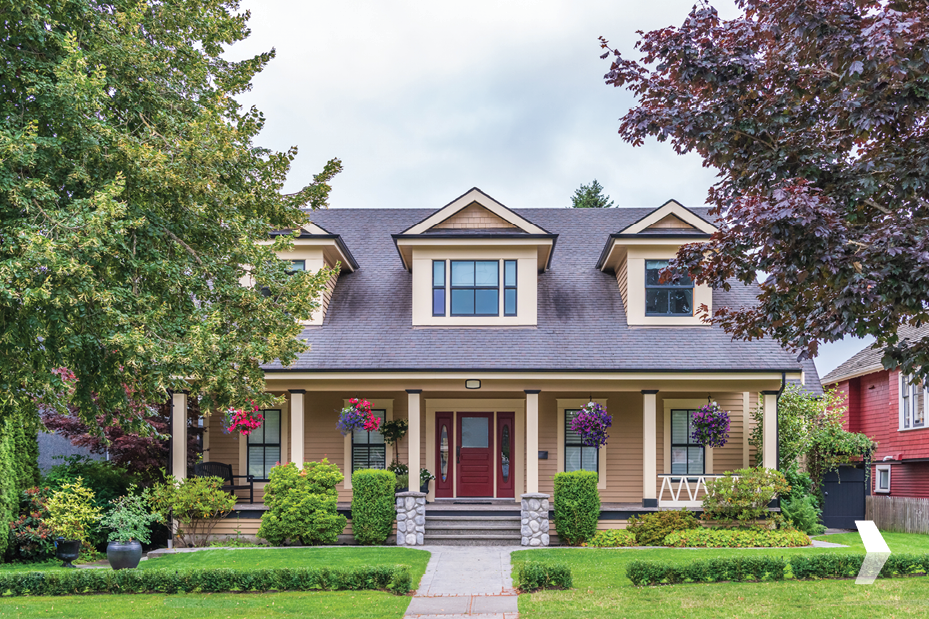Preparing Financially for Parenthood and Homeownership
Melair Holterhoff Martinez, CMA, Sr. Mortgage AdvisorSeptember 4, 2023 — 15 min read

The arrival of a child is exciting enough, but when it’s coupled with the need to buy a bigger space, it can quickly
start to feel overwhelming. The joy of expanding your family may be tinged with the stress of finding the perfect home to accommodate your growing needs.
But with careful planning and our expert help, it can be a smooth and rewarding adventure. The key is to create a well-thought-out strategy that balances your family's needs and your aspirations for the ideal home. Use these facts and insights to help prepare for the challenges ahead and navigate the wild world of parenthood—and homeownership—with confidence and ease.
Preparing Financially for Parenthood and Homeownership
Create a Comprehensive Budget
Start by evaluating your family's current and future requirements. Consider the number of bedrooms you may need, proximity to schools and parks, and other essential amenities to enhance your quality of life.
Next, create a comprehensive budget to serve as a cornerstone for all important decisions moving forward. Parenthood comes with a lot of extra expenses, like diapers, healthcare, and education, among others. Factor these costs into your budget and adjust as needed.
New to budgeting? Here’s a popular method that may help:
- Put 50% of your income towards essential needs, such as household bills, loan payments, and expenses like child care, diapers, and formula; this ensures that fundamental requirements are met, providing stability and security for your family's day-to-day living.
- Next, allocate 30% of your income towards financial wants. This allows you to enjoy some discretionary spending, such as entertainment, dining out, and leisure activities. It's essential to strike a balance.
- Lastly, reserve 20% of your income for savings. Prioritizing savings is crucial for building an emergency fund and investing in future financial goals, like your child’s college savings.
Once you have a small stash of emergency cash to cover unexpected expenses, your immediate financial priorities should look something like this:
Retirement savings. Ideally, you should set aside at least 15 percent of your income and contribute enough to your 401(k) to get the maximum employer match, if available.
Paying off debt. Begin by focusing on high-interest debts, such as credit card balances or a payday loan, to minimize interest costs and free up resources for savings and investments.
Building emergency savings. Work your way to saving three to six months' worth of living expenses in a separate, easily accessible account. This fund will act as a financial safety net during unexpected events, such as medical emergencies or job loss.
Start Saving for a Down Payment
In addition to creating a comprehensive budget, it’s important to start saving for a down payment as soon as possible.
Calculate your savings goal. Decide on the size of the down payment you aim to make for your future home. While this can be an estimated amount, it's essential to ensure that your financial expectations align with the number you have in mind. For some homebuyers, a 20% down payment might be the ideal choice; for others, especially first-time buyers or those seeking greater financial flexibility, a smaller percentage might be more achievable.

RELATED: Low and No Down Payment Mortgage Options
Determine your timeframe. The size of your down payment will directly impact your savings goal, but it's equally important to factor in life events, such as starting a family. If you plan on having a child within your designated savings timeframe, it's essential to account for associated costs, including prenatal care, delivery expenses, and childcare. Moreover, consider other potential situations that might hinder your ability to save for your down payment. Are there plans for home renovations in the near future? Are there major life events, such as marriage or job changes, on the horizon? Additionally, account for possible medical expenses or emergencies that may arise.
Budget, budget, budget. Now that you've established a clear timeline and savings goal, it's time to determine the sources of this money. If your savings goal surpasses your current saving habits, you’re going to have to make a few changes. Consider picking up a side hustle or reassess your spending to align with your financial objectives for each paycheck. Embrace creativity when trimming your budget; often, it's the small expenses that accumulate over time!
Consider the following cost-cutting measures:
- Skip the drive-thru and pack your lunch
- Make your coffee at home instead of buying it
- Opt for a public park or open space for your workouts instead of a gym membership
- Rent a movie at home instead of going to the theater
- Work a few extra hours rather than going home early
Consider additional costs. While saving for a down payment is essential, it's crucial not to underestimate the smaller yet significant fees associated with buying a home. These may include:
- Mortgage Insurance. Depending on the type of mortgage and down payment amount, you may need to budget for mortgage insurance, which protects the lender in case of default.
- Appraisal and Inspection Fees. Before finalizing the purchase, an appraisal and home inspection are typically required to assess the property's value and condition. These fees ensure you're making an informed choice.
RELATED: Inspect or Not to Inspect? Your Easy Guide to Property Inspection Waivers
- Closing Costs. When you close on the property, there are various fees associated with finalizing the sale, including title fees, attorney fees, and other administrative costs.
RELATED: Understanding Closing Costs: Planning for the Financial Aspects of Homeownership
Remaining committed to your savings goal no matter the obstacles life throws your way will enable you to navigate these additional costs with ease. If you have questions about your down payment or additional costs associated with a home purchase, reach out to your neighborhood Mortgage Advisor today.
Mortgage Options for Families with Young Children
Understanding the different mortgage types is crucial to making an informed decision that aligns with your financial goals and family's needs.
Fixed-rate mortgage. This loan option offers a stable interest rate throughout the loan term, providing predictability and ease of budgeting for families.
Pros:
- Consistent monthly payments
- Protection against rising interest rates
Cons:
- Initial interest rate may be higher compared to an adjustable-rate mortgage
- Fixed-rate loans typically come with longer terms, such as 15 or 30 years; while this may offer lower monthly payments compared to shorter terms, it also means committing to the mortgage for a longer period.
Adjustable-rate mortgage. This option offers an initial fixed-rate period, after which the rate adjusts periodically based on market conditions. This can make sense for families who only anticipate living in a home for a few years.
Pros:
- Lower initial interest rate during the fixed-rate period, which means lower monthly payments compared to a fixed-rate
- If the market indicates a decline, you may benefit from reduced monthly payments in the future
Cons:
- Once the fixed-rate period ends, the rate adjusts based on prevailing market conditions; this can lead to fluctuations in monthly payments, making budgeting and financial planning more challenging
- If you anticipate living in the home for an extended period, the uncertainty of future rate adjustments may not align with your financial goals
2-1 Buydown. This is a specialized mortgage option that offers families an initial reduced interest rate during the early years of the loan. This can be an attractive choice for families who expect their income to increase in the future or who need short-term financial relief during the early years of homeownership.
Pros:
- Borrowers can enjoy lower monthly payments during the first two years of the mortgage
- Following the initial two-year period, the rate gradually increases to the initial note rate, providing families with time to adjust to their increased monthly payments
Cons:
- Families must be prepared for the rate to adjust after the first two years. The potential for rising rates means that monthly payments will increase, and budgeting will need to account for this change
RELATED: Buydown Mortgage vs. ARM: Which is Best in a Rising Rate Environment?

FHA loan. This government-backed loan option is designed to help first-time buyers and those who are still building their credit and savings.
Pros:
- You can qualify with a down payment as low as 3.5% of the home's purchase price
- FHA loans are generally more lenient when it comes to credit score requirements
- Typically, these loans allow for a higher debt-to-income ratio
- Typically, these loans come with fewer closing costs than a conventional loan
Cons:
- Mortgage insurance is required
- FHA loans have specific limits on the amount that can be borrowed, which vary by location
- There are specific property requirements and the home must meet certain standards to be eligible for financing
RELATED: How Debt to Income (DTI) Ratio Can Affect a Borrower's Mortgage
VA loan. This mortgage option, backed by the U.S. Department of Veterans Affairs, is available exclusively to eligible veterans, active-duty service members, and some surviving spouses.
Pros:
- Eligible borrowers can purchase a home with no down payment
- No monthly mortgage insurance is required
- Lower interest rates than conventional products
- Flexible qualification criteria
- Lifetime benefit
Cons:
- One-time funding fee that varies based on the borrower's military service and down payment amount
- Available only to eligible veterans, active-duty service members, and some surviving spouses
To qualify for a VA loan, you must have sufficient credit and income and a valid Certificate of Eligibility (COE). If you are unsure if you meet these requirements, contact your neighborhood Mortgage Advisor.
USDA loan. This government-backed mortgage option, offered by the United States Department of Agriculture (USDA), is designed to support rural and some suburban homebuyers with low-density population centers.
Pros:
- There is a no down payment option
- These loans have more relaxed credit requirements, making it easier for borrowers with less-than-perfect credit
- USDA loans have lower rates than some other types of mortgage loans, which can result in significant savings over the life of the mortgage
Cons:
- Only available for properties in designated rural or suburban areas
- Income limits are based on the area median income and total household income; families exceeding these limits may not be eligible
- There is a one-time upfront guarantee fee and an annual fee for mortgage insurance
Preparing for Homeownership
Once you’ve worked out a comprehensive budget and are familiar with the different loan options available to you, it’s time to start taking tangible steps. Keep these tips top of mind before, during, and after your home search:
Get pre-approved for a mortgage. Getting pre-approved for a mortgage should be a top priority before beginning your home search; during this crucial step, your lender will assess your current finances, credit history, and income. By securing pre-approval, you'll gain a clear understanding of your budget and available loan options. You’ll also demonstrate your seriousness as a buyer to sellers, potentially giving you a competitive edge in a competitive market.
RELATED: Understanding the Pre-Approval Process
RELATED: Simple & Safe Strategies to Help You Win in a Seller’s Market
Home inspection and appraisal. Generally, before finalizing a home purchase, it’s important to conduct a thorough home inspection. Hiring a certified home inspector will help identify any potential issues or necessary repairs in the property. Additionally, the lender will require a property appraisal to determine its fair market value. Depending on the inspection and appraisal results, you may negotiate with the seller for any necessary repairs or reassess the offer based on the property's value.
RELATED: Inspect or Not to Inspect? Your Easy Guide to Property Inspection Waivers
Closing and moving. The final step in the homeownership process is the closing, where all legal documents are signed and ownership of the property officially transfers to you. During this stage, you'll work closely with your real estate agent, the lender, and the seller's representative to coordinate the closing date and ensure all necessary paperwork is in order. Be prepared to review and sign various documents, including the loan agreement, title documents, and insurance policies.
RELATED: Understanding Closing Costs: Planning for the Financial Aspects of Homeownership
Once the closing process is complete, it’s time to prepare to move into your new home! Create a moving checklist and start packing early to minimize stress and ensure a seamless transition. If needed, hire professional movers to help with the heavy lifting and transportation.
RELATED: How to Prepare for Your Long- or Short-Distance Move

Other home-buying considerations for new parents:
Location. This is a critical factor to consider when choosing a house, as it’s not something you can change later. Do some practical research into the neighborhoods you’re considering to gain information on median home values, crime rates, school district, and other unique factors about the neighborhood. Here are some helpful resources to help you get started:
- neighborhoodscout.com (view your home value and other statistics)
- cityprotect.com (learn about crime in your neighborhood)
- Federal Bureau of Investigation Crime Data Explorer (check crime in your state)
Additionally, reaching out to the city planning department can reveal any major development plans that may impact the area's livability and future resale value of the home. For instance, the construction of a new mall nearby could lead to increased investment and rising home prices, while a new factory may negatively affect air quality and noise levels, potentially causing house values to decline.
RELATED: How to Pick the Right Neighborhood for You
Schools. When it comes to finding the perfect home for families with kids, proximity and quality of schools takes top priority. The education your children receive plays a significant role in their development and future opportunities.
RELATED: The Significance of School Districts When Buying a Home
GreatSchools.org is a popular resource when it comes to researching school districts. Using the address of a potential home, parents can access a wealth of information about nearby schools, including their ratings, performance on standardized tests, and reviews from other parents and students.
When evaluating schools, it's also important to consider their focus on extracurricular programs, arts, and sports; additionally, parents should consider safety and discipline policies to ensure a comfortable learning environment.
Bedrooms. Having children's bedrooms nearby allows parents to respond quickly to their needs, whether it's in the middle of the night or during daytime naps. In a home layout where the master bedroom is located on a different floor from the other bedrooms, parents may have to navigate stairs and longer distances to reach their children's rooms. This layout could become even more challenging during the early years when children may require frequent attention during the night.
Babyproofing. When a child starts to crawl or walk, babyproofing your home becomes a necessity. Start by thoroughly inspecting each room in your home to identify potential dangers. Pay close attention to the location of the furnace, water heater, and other appliances that emit heat; install safety gates or barriers around these areas to prevent your child from getting too close.
Power outlets can also pose a significant risk to curious toddlers. Invest in outlet covers or safety plugs to prevent your child from sticking their fingers or objects into the outlets. Consider using furniture or cord covers to keep electrical cords out of reach and prevent tripping hazards.
Here are other actions you can take to make sure your home is baby-safe:
- Install baby gates at the top and bottom of staircases; if your home has banisters or railings with large gaps, secure them with banister guards to prevent your child from getting stuck or falling through.
- Secure kitchen and bathroom closets with childproof locks or latches to restrict access and keep dangerous items out of reach, such as cleaning supplies.
- Anchor heavy furniture, such as bookshelves and dressers, to the wall to prevent them from tipping over if your child tries to climb on them.
- Consider installing corner protectors on sharp furniture edges to minimize the risk of bumps and bruises.
- Regularly scan the floor and low-lying surfaces to ensure no small items, such as coins, batteries, and other choking hazards, are loose.
Yard care. If the home you are considering includes a yard, there are several essential factors to consider, especially if you have young kids:
- Consider the visibility of the yard from the main living areas of the house, such as the kitchen or living room; ideally, the yard should be easily visible from these spaces, as it allows you to keep an eye on your children while they play outside.
- If the yard is near a road or a busy street, installing a sturdy and secure fence becomes crucial—with this added layer of security, it’s easier to keep intruders out and, more importantly, ensure your kids stay safely within the confines of the yard.
- In cases where there is a pond, pool, or any other water feature in the yard, take measures to prevent unsupervised access. Drowning is a significant concern for young children, and even small bodies of water can pose a serious risk. Consider safety measures such as pool fences, pool covers, or alarms that can alert you if someone enters the water without supervision.
Ready for First Steps?
Being a new parent is hard enough— if you’re ready to take the next step in your homeownership journey, let us make it easy for you. Contact your neighborhood Mortgage Advisor today, or click here to receive a customized quote.
Keywords:
Categories
- Financing
- Credit
- Buyers
- First-Time Homebuyers
- Purchase Programs
- Purchase Products
- Homeowner Knowledge
Archives
Recent Posts
- No Down Payment for First-Time Homebuyers
- How Does A 30-Year Mortgage Work: A Simple Guide
- Your Comprehensive Homebuying Checklist: A Step-By-Step Guide
- Mortgage Pre-Approval: Everything You Need to Know
- What Are the Benefits of a USDA Loan for Homebuyers?
- How Many People Can Be On A Home Loan? Your 2024 Guide
You bring the dream. We'll bring the diagram.
There’s a financing solution for just about every situation.
I felt like I was treated like family, great communication and helping me with any questions I had.

You bring the dream. We'll bring the diagram.
There’s a financing solution for just about every situation.
Where does your sun shine? Find your local advisor.
Enter your city or state to see advisors near you.
